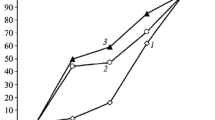Abstract
As established by a DTA and high-temperature x-ray diffractometric study, the phase transition of high-temperature protoenstatite to clinoenstatite on cooling is related to the crystal size. Methods are proposed whereby it is possible to make thermally stable, nonaging steatite ceramics with the protoenstatite crystallized into extremely fine grains. In this way, nonaging steatite ceramics of improved service properties can be produced.
Similar content being viewed by others
References
A. S. Berezhnoi,Multicomponent Oxide Systems [in Russian], Naukova Dumka, Kiev (1970).
W. Éitel’,Physical Chemistry of Silicates [Russian translation], Inostrannaya Literatura, Moscow (1962).
P. G. Usov and V. N. Gurina,Izv. Tomsk Polytech. Inst.,234, 53–56 (1974).
P. G. Usov and V. N. Gurina,Izv. Tomsk. Polytech. Inst.,174, 48–51 (1970).
Author information
Authors and Affiliations
Additional information
Translated from Steklo i Keramika, No. 11, pp. 31–33, November, 1997.
Rights and permissions
About this article
Cite this article
Vereshchagin, V.I., Gurina, V.N. Polymorphism of magnesium metasilicate and its role in the production of nonaging steatite ceramics. Glass Ceram 54, 365–367 (1997). https://doi.org/10.1007/BF02768184
Issue Date:
DOI: https://doi.org/10.1007/BF02768184




